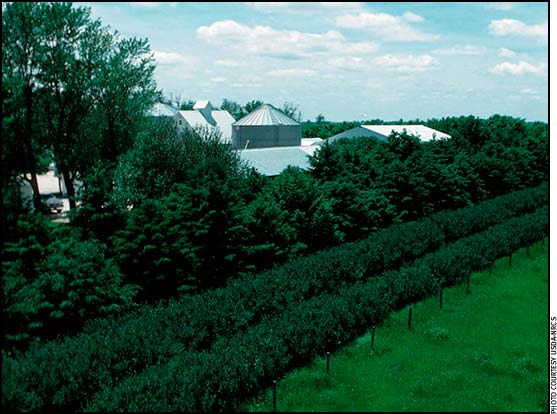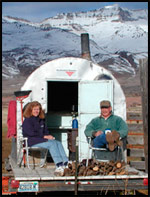MANAGEMENT...

Consider Windbreaks to
Shelter Livestock
Windbreaks can reduce feed costs, help cattle maintain weight.
Established tree windbreaks sheltering beef and dairy cattle operations can save producers money on feed costs, weight loss and milk production during the winter months.
A heavy winter coat protects beef cattle until temperatures drop below 18° F, but beyond that point, Bob Atchison with the Kansas Forest Service said the animals require additional feed to maintain body temperatures. The presence of a windbreak can help remedy this problem.
“A 25 mile-per-hour wind at 0° Fahrenheit creates a wind chill of 44° below zero,” said Atchison. “By contrast, a properly designed windbreak will reduce the same wind chill to 15° below zero.” Read more.

Ron Torell with his wife, Jackie
Cow Camp Chatter
Cow tales.
Many of the conversations those of us in the cattle business have around the branding fire or over the hood of a truck center on the behavior and internal workings of the bovine. When something out of the ordinary happens to spark our curiosity, we may question if there actually might be a possible explanation. Consider the following thought-provoking cow tales, some of which have been substantiated by research.
- Nearly every cow person at one time or another has questioned why some cows will eat the afterbirth after they’ve calved (placentophagia). One theory is that they eat it for bonding purposes. This may be true, but then again there are a large percentage of cows that bond with their calves without eating the afterbirth. Read more.

Kris Ringwall
Beef Talk
Get a firm grasp of your calving distribution.
Reviewing cow herd reproduction dates is important. Typically, 85% or more of all cows should be calved within 42 days of the start of the calving season. During the many upcoming winter meetings, the number of cows calving within the first 21 days of the calving season or the first-cycle conception rate will be mentioned often.
Do you know yours? The number means a lot because early-born calves grow well. These calves are indicative of good reproductive success and ultimately add pounds to the truck. However, care needs to be taken to make sure one always is comparing the numbers presented at meetings with one’s own production numbers. Read more.
Formalize Lease
Leases help landowners, tenants know expectations.
University of Missouri (MU) Extension agribusiness specialist Karisha Devlin urged northeastern Missouri agriculture lenders to encourage written agreements between landowners and renters during a recent agricultural lender seminar at Fiddlestiks restaurant in Hannibal, Mo.
“Half of all leases are done on a handshake, but termination becomes very messy and complicated when it’s a verbal lease,” Devlin said. “Farming is a business. Why would you not have a formal written agreement for a business? Make sure both sides are protected.” Read more.
Alternative Feeds
Drought has many ranchers looking for alternative forages.
After this year’s drought, many ranchers are looking at alternative forages for winter feed. Glenn Nader, University of California Cooperative Extension livestock and natural resources advisor for three counties, says this year there is a lot of demand for rice straw and cornstalks. With the increase in ethanol plants, more corn is being grown, so stalks are sometimes an option.
“In the past, farmers here just tilled them under, but in the Midwest people have been grazing dry cows on cornstalks for a long time,” he says. Now western ranchers are looking at hauling baled cornstalks from nearby farming regions. Read more.
New Products
Industry affiliates provide a wide array of products and services to assist you on the farm and ranch. Here's an assortment of new products to hit the market recently.
- Extended-release cattle wormer
- Book release: Pat Goggins: As I Saw It
- Protect round-bale quality
- John Deere app
- Cordless trimmer/edger
- Transport two bales in one trip
- Tailor the TIG welding arc
Angus Advisor
Click here for January herd management tips from cattle experts across the nation. Advice separated by region.
[Click here to go to the top of the page.]











